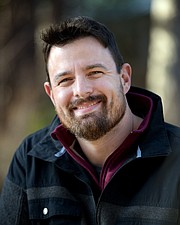Deep Dive into the Flathead Lake Bio Station with Ian Withrow
“Everything in moderation” can be a tough phrase for me to swallow. Especially this time of year, when grocery store marketing does a number on me and it takes everything I have to avoid those barbecue and s’mores displays in favor of the produce section, where nutrient-rich fruits and vegetables are waiting to do my body good.
When it comes to diet, balance can be difficult. When it comes to health and sustainability, balance is essential. This applies to the food web of Flathead Lake, which is dependent upon a delicate and specific ratio of nutrients. These nutrients, largely nitrogen and phosphorus, provide the building blocks for life. They’re first ingested by microorganisms and subsequently serve as the nutritional foundation for the next largest organisms and so on, until they are ultimately contained in a campfire-roasted lake trout on your dinner plate.
This brings us to the somewhat delicate topic of this month’s column: Our waste. Not the trash we throw out … the other waste, the stuff we’re less keen to talk about. For much of history, human waste and wastewater went untreated, and because human waste concentrates nutrients, the untreated wastewater created a tremendous influx of nitrogen and phosphorus into freshwater ecosystems. This overabundance polluted water world-wide, making it unsanitary and causing unsightly and at times toxic algal blooms.
As a result, wastewater treatment became a priority all over the world. This has since become extremely effective at removing phosphorus — a dominant element in human and animal waste — from wastewater before returning it to an ecosystem … and it worked! By the early 1990s, wastewater treatment plants in the Flathead were upgraded for low-level phosphorus removal, and Bigfork’s current wastewater treatment plant is extremely effective at removing nutrients.
Societal investments in this technology have benefited Flathead Lake, which remains clean and blue. Toxic algal blooms went away. Water became more sanitary. The problem, it seemed, was solved. But as more phosphorus is stripped disproportionately by wastewater treatment, the greater the nitrogen-to-phosphorus ratio becomes. Are there consequences to these advancements in wastewater treatment disturbing the balance of nutrients?
FLBS Director Jim Elser is attempting to answer that very question. In a recent study published by the National Academy of Sciences, Elser joined an international research team to help uncover potential impacts that advancements in wastewater treatment can have on the ecological health of freshwater ecosystems. Additionally, utilizing data from the Bio Station’s Flathead Monitoring Program, and research provided by students in his field ecology summer class, Elser has documented an increasing nitrogen-to-phosphorus ratio in Flathead Lake.
What does that mean for us? While there is still research to be done, a logical line of speculation can be drawn.
In Flathead Lake, microorganisms require a specific combination of nitrogen and phosphorus to survive and grow. When there is little or no phosphorus in the water, the growth and reproduction rates of these microorganisms (remember our Dear Little Daphnia?) slow down. There are two undesirable consequences of this: In the short term, with less microorganisms to eat algae, the clear water of Flathead could begin to turn green and murky. In the long term, fewer microorganisms would mean less food for larger organisms, which could result in fewer and smaller fish.
It is ironic that well-intentioned use of modern technology could cause this imbalance within our natural ecosystems. But it is likely that scientific inquiry, human innovation and use of technology could return the balance to normal, where Flathead Lake holds an appropriate ratio of nitrogen and phosphorus, the microorganisms flourish, the water remains clear and the fish are large and plentiful.
Maintaining a healthy balance of nitrogen and phosphorus in Flathead Lake is a worthy effort, beneficial to the ecological, economic and recreational health of Flathead Lake. Knowing that FLBS will continue to monitor and serve as Sentinel of the Lake for many years to come is a deliciously reassuring thought. ■



